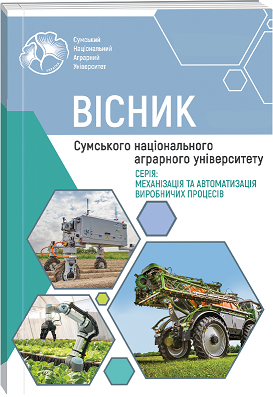OPTIMIZATION OF PLACEMENT OF EQUIPMENT FOR FLEXIBLE MANUFACTURING SYSTEMS
Abstract
The layout of flexible mfnufacturing systems (FMS) largely determines the technical and economic performance of the equipment of the site, workshop and enterprise as a whole (Pukhovskiy E.S., Malafeev U.M., Dobrianskiy S.S. (2015)). The arrangement of the main technological equipment (MTE) in the FMS is determined by the production capabilities, the volume of products and the nature of the parts being processed. General layout schemes for the placement of equipment are determined by organizational and technical requirements: technological links between sites and workshops, the structure of the system of tooling of sites and individual processing modules, technical conditions for the operation of buildings, structures and communications (Increasing of the efficiency of flexible manufacturing system. (2016)). Structural and layout solutions of a flexible automated site depend on organizational and technological solutions in the workshop, the direction of material flows, the types of automated vehicles used and their docking devices, the nature of tool support systems and production waste disposal (Increasing of the efficiency of flexible manufacturing system. (2016)). After sign of the direction of material flows of objects and means of labor relative to storage areas and processing areas can be distinguished the following main layouts of FMS: radial, linear, T-shaped, closed, vertical, combined (Azab A., El Maraghy H.A. (2007); Pukhovskiy E.S. Problemi proektuvannia GVS. (2009)). According to the radial layout, traffic flows diverge in the radial direction: from the central drive to the equipment located around the storage area. This layout is convenient for the processing module, which consists of several units centered around the rack with an industrial robot (IR). With a radial layout, traffic flows diverge in the radial direction: from the central drive to the equipment located around the storage area. This layout is convenient for the processing module, which consists of several units centered around the rack with IR (Increasing of the efficiency of flexible manufacturing system. (2016)). Linear layout is used, for example, when transporting goods by a warehouse stacker directly to machines stretched out into a line. The stacker acts as a transport device that serves the warehouse and processing equipment. This type of layout is quite common, since the machines can be located on one or both sides of the service route with a parallel or perpendicular installation scheme relative to the route (Matta A., Samerato Q. (2006)). With the parallel arrangement of machines along the route, it is convenient to use any automated vehicles – floor and suspension, but some stretching of the route and increased in this regard, the need for areas, increased load on vehicles, the need for their additional quantity for transportation to the machine tool and equipment create some complications and are the main disadvantages of the parallel arrangement of equipment (Design of Flexible Production Systems. (2009)). In the case of perpendicular arrangement of equipment to the highway, greater compactness of planning and, therefore, less need for production areas are achieved, the ability to provide workplaces with the help of one vehicle with blanks, tools and equipment, the use of both floor and suspended robots for transport purposes. The disadvantages of this layout are the increased load on the vehicle, the presence of additional requirements for production areas and the complexity of organizing work in the workplace (Increasing of the efficiency of flexible manufacturing system. (2016)). In the case of a T-shaped layout, the machine maintenance routes are perpendicular to the storage routes. This type of layout increases the flexibility of the system and contributes to an increase in the storage of parts while increasing the scale of production. In ring layouts, the transport route of an arbitrary trajectory is closed. The storage area is located along the section of the route. This layout is very convenient when working on the highway of several vehicles, as it makes it possible to expand the service optimization area by eliminating returns and reducing the delivery routes of workpieces and equipment (Design of Flexible Production Systems. (2009)). The vertical layout involves placing the storage and maintenance area at different levels. The transfer of blanks and equipment takes place in a vertical plane. Combined layouts, combining several sections, provide maximum flexibility and minimal transport movements in the case of different placement of technological equipment. When developing the layout of the FMS, it is necessary to take into account all the parameters affecting the construction of the system: the type of parts being processed, the route and technological processes for manufacturing parts, the number and types of equipment and workplaces, construction solutions for industrial premises and buildings, technological design standards (Guash A., Piera M., Figueras J. (2011); Manufacturing Systems. – Theory and Practice. (2005)). The purpose of the work: Improving the efficiency of flexible manufacturing systems by minimizing the area of FMS placement, reducing the cost of transport maintenance of equipment and optimizing organizational, technical and technological connections.
References
2. Design of Flexible Production Systems. (2009), Metodologies and Tools. By T. Tolio. Berlin: Springer, ISBN 978-3-540-85413-5.
3. N. Manesku, A. Nedelcu, (2015), Flexibility and efficiency analysis of a flexible manufacturing system. Romania. Rewiew of the Air Forse Academy, N1, (28).
4. Flexible versus efficiency? (1999). A case study of modern changeover in the Toyota Production System. P. Adler, B. Goldoftas, D. Levine, Unuvercity of Southern California, Los Angeles. Organisation Science/ vol. 10, N1, june.
5. Guash A., Piera M., Figueras J. (2011) Automatic warehouse modelling and simulation. International Journal of Simulation. Process modelling, 6(4), 228-296.
6. Yakimovitch B., Korshunov A., Sviatski V. (2016), Increasing of the efficiency of flexible manufacturing system. International conference of manufacturing engineering. 6-10 june, Novy Smocolec, Slovacia. https://doi.org/10/j.proeng.2016.06.709
7. Manufacturing Systems. – Theory and Practice. (2005), By G. Chryssolouris. New York, NY: Springer Verlag. 2nd edition, 233 p.
8. Matta A., Samerato Q. (2006), 200Design of advanced manufacturing systems. Springer, The Netherlands.
9. Megrabi M.G., Ulsol A.G., Koren Y., Heytler R. (2022), Trend and Perspectives in Flexible and Reconfigurable Manufacturing Systems. April, 20 Journal of Inteligent Manufacturing Systems, 13(2) / DOI: 10.1023/A:101453633051
10. Migel A.S., Vagner G.M. (2019), Implementation of a Flexible Manufacturing Systems in a production of the automative industry. decision and choice. University of Vale do Rio. – Brasil, DOI: 10.1590/0103-6513.20180092.
11. Modeling, Simulation and Control of Flexible Manufacturing Systems. (1999). By (autors): Meng Chu Zhou (New Jersey Institute of Technology, USA) and Kurapati Vencates (New Jersey Institute of Technology, USA)., 428 p.,
12. Pukhovskiy E.S. (2009), Problemi proektuvannia GVS. [Problems of FMS dtsign], Visnik NTUU(KPI), Mashinosnroenie, N56, S. 127-134. [in Ukrainian).
13. Pukhovskiy E.S., Malafeev U.M. (2017), Proektuvannia gnuchkikh virobnichikh system mashinobuduvannia. [Design of flexible manufacturing systems of mechanical engineering], chast 1, NTUU(KPI), – 286 s. (in Ukrainian).
14. Pukhovskiy E.S., Malafeev U.M., Dobrianskiy S.S. (2015), Proektuvannia gnuchkikh virobnichikh system mashinobuduvannia. [Design of flexible manufacturing systems of mechanical engineering], chast 2, NTUU(KPI), – 204 s. (in Ukrainian).
15. Veselovskaia N.P. (2015) Analis verstatnikh komplexiv mekhanichnoi obrobki v mashinibuduvanni. [Analysis of machine tool complexes of mechanical processing in mechanical engineering]. Vinnitza, VDU, 8 s. (in Ukrainian).

 ISSN
ISSN  ISSN
ISSN 



